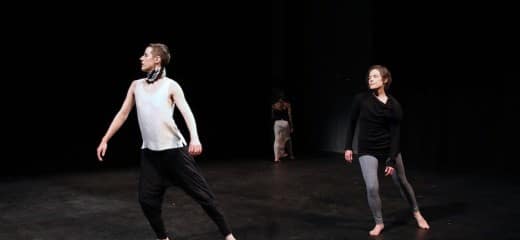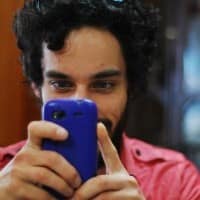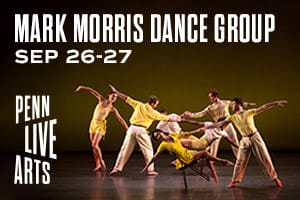What happens to our flesh in the digital age? In the program notes to Sp3 (shorthand for “space, pattern, pulse, and presence”), which played for three nights at FringeArts last weekend, FIDGET’s Megan Bridge* and Peter Price talk about alienation and division: we are separated from one another by digital communications and convenience, and also by political and class divides. We don’t touch like we once did. “[S]imply being together has become a political act,” they claim, a horrific vision in its obliteration of the personal.
Sound.
Sp3 is composed by Price and choreographed by Bridge. Price’s 60-minute sound score begins with distant scratching. First, I think it could be feet moving across the floor above us; then, I am almost certain it is the sound of a pen moving across paper on a wooden table.
These irregular soundscapes fade out quickly; for the majority of the hour, the composition is true to the title’s promise of pulse and pattern. I struggle post-show to remember specific moments of the score. I recall attempting to count beats (is this 4/4? 6/4? 12/4?) and being foiled by Price’s complexly overlapping oscillations; the thudding and popping of his abstracted heartbeats seep right through my skin but move too quickly for me to analyze them. The music does not leave the space with me except in my memory of the dancers, as their bodies interpret pulse and pattern.
Feeling.
A relentlessly “neutral” expression masks the dancers: piercing gaze fixed in the middle distance, lips at rest, cheeks etched and linear. This is most meaningful, though, where it relents. Sp3 begins with a kind of prologue. Bridge and Stoyanova stand downstage, a foot or so apart, in a craggy shock of light (lighting by Mark O’Maley), loosely and unsentimentally holding hands. Bridge’s eyes are relaxed; she scans the crowd (this direct eye contact never happens again). Stoyanova’s face cracks, wide mouth, crinkly eyes, tongue unfurled and taunting: Kali face. Bridge glances at her and Stoyanova returns to neutral, with a slight smile. Don’t take this all too seriously, the sequence suggests.
Presence.
Bridge performs the single extended solo, which occurs right around the middle of the score. Though Sp3 is broken into individual movements separated neatly by blackouts, only one of the twelve or so movements is completely solo. The choreography of Sp3 is intentionally repetitive, with movements re-quoted and re-quoted in new contexts; so, in this solo, Bridge is doing little which has not been done before. But it feels slightly slower, slightly more embodied—as if, instead of automatically following impulses from without, she is experiencing and choosing the flow. In the middle of the solo, the light plot changes from a crystalline, fragmented net of blue to a blue field. Bridge pauses and breathes. She is not “with us,” as she was at the start of the evening when she met our eyes, but she is here, present, in her body.
Breath.
Kat Sullivan kneels. She wears loose pants, no shirt, and has a line painted up and down her center from front to back (a seam). In a single spot of light, she ripples up, following a pulse which travels up her spine, into her arms and then up her neck, then she collapses. It’s a single movement which could look like prayer if it was not so abstracted and cold. More than anything it looks like she is inflated with air for a moment, then deflated. Then she inflates again. This is relentless and unchanging. (Pulse. Pulse. Pulse.) The lights fade, then come up again; Bridge, in another spot and similarly (un)dressed, with the same seam, joins her, and (though not in unison, or even on the same rhythm) they continue together.
I cannot escape the thought that they are transformers, engines in a massive machine, generating energy through their simple up and down. But: they are human. They may have a seam, as if they were manufactured, but their nakedness (the only costume change in the piece) reminds us that they are individual, human, alive, and maybe even vulnerable.
Strained seriousness.
Can post-humanness even be achieved in a medium based on physical presence?
Bridge’s movement vocabulary, which is in many ways the subject of this piece, constantly worries on a single sore spot: the tension between a kind of strained seriousness (read: we are bodily animated by our machines) and a kind of shake-it-all-out, human sensual realness. As pulse generates energetic flows in her dancers, we can feel this tension working itself up. We feel both modern and jazz rubbing against the same joint. A body is possessed by a series of isolations: the shoulder raises and rotates forward and back, then the hip circles left to right and the semi-stiff leg follows. Immediately afterward, the dancer lightly shifts her weight back and forth as she hops from foot to foot while swaying her arms backward through space.
We oscillate between two realities; our bodies are held captive by architecture, both concrete and digital, by pulse and pattern and space, but we are still human bodies with presence. And ultimately, aren’t pulse and pattern also from within?
Touch.
At times, all the dancers are on stage, performing sequences separately, connected only by the droning pulse of Price’s score. They perform different actions, but they are somehow in a single flow. In other movements, all the dancers perform the same actions, beginning in unison but disbanding quickly. Later, they sync up for a single, joyful moment.
When Bridge gives us connection or touch, it is almost always abstracted: bodies don’t join except rhythmically, through shared action. Yet Sp3 begins with two bodies (coldly, absently) holding hands, and this gesture is repeated occasionally. It’s so wilty, though (cold fish hands), that I receive no meaning from it. Touch, and its implications, are problematized.
Are we only connected by the forces which shape us? Sp3, with its droning score, stark, expressionist lighting, and machinist choreography could easily alienate. But I emerge from the performance energized. While I certainly feel reinforced in my belief that we are drifting further and further from one another, I also think: every movement in Sp3 takes this distance for granted and asks, But in what ways are we still close? In what ways are we still here? What do we still all have in common?
Sp3, FringeArts, Feb. 1-3, http://fringearts.com/event/space-pulse-patten-presence/
* Note: Megan Bridge, Megan Wilson Stern, Zornitsa Stoyanova, and Kat Sullivan are all writers for thINKingDANCE.






